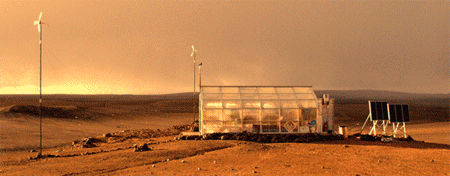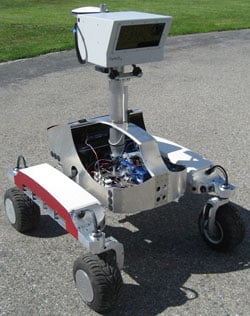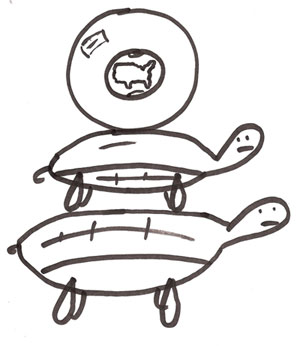This article is more than 1 year old
NASA preps robots for future fake moon landings
Celebrates 38th anniversary of special effects excellence
Creeping slowly over the permafrost locked within the arid and isolated polar desert of the Haughton Crater, two robots survey the world around them.
From a low resolution video feed at the NASA Ames Research Center in Silicon Valley, it's hard to distinguish the landscape surrounding the robots from the surface of Mars, or even the moon. If it weren't for three scientists in casual attire sitting front and center, it would be a dead ringer for a snapshot from a Martian probe.
For 10 years, scientists have utilized the polar desert within the ancient impact crater at Deveon Island, Canada as an analog to extraterrestrial worlds. Today, a group of scientists have gathered to discuss the experiments that are now taking place.
Their new mission: to prepare to fake another moon landing.

Haughton Crater, picture courtesy NASA
The outer limits
Thirty eight years ago today, mankind achieved the impossible** by first setting foot on a soundstage in the Nevada desert to fake our first steps on another planetary body.

It was a stunning spectacle, outweighing even the 1902 French silent film "Le Voyage dans la lune" in realism and style. And the public ate it up. To further appease the masses, NASA would return to fake moon landings several more times. Sadly, 35 years ago, the glamor and awe faded from our collective fancy. The agency reluctantly closed the doors on its moonscape. The magic was gone.
But a new initiative is on the horizon. NASA is planing to once again fake a moon landing by the year 2020. This time, they even hope to simulate the construction of a lunar outpost. But faking the harsh terrain and permanently shadowed areas of the lunar surface is no easy task.
There's tons of data to forge, payloads of moon rocks to papier-mâché, American flags to starch, and trickiest of all — there's the secret leaks of information to the nation's most wide-eyed paranoids.
Not to mention it's going to be 2020. People are going to expect better special effects. That's where the robots come in.
The robots of Drill Hill
The autonomously controlled K10 Black and K10 Red represent the future of extraterrestrial fakery. The robots are equipped with 3-D laser scanners and ground-penetrating radar, which can survey any studio built to resemble the rough terrain of moon with utmost realism.

K10 Red, picture courtesy NASA
The 3-D laser scanner can map topographic features up to 3,280 feet away. The ground-penetrating radar, which NASA's Jet Propulsion Laboratory developed, can map below ground as deep as 16.4 feet.
When NASA establishes its mock lunar outpost, detailed surveys will be needed at a variety of sites to layout infrastructure, to prospect for resources and to plan fake excursions for the astronauts. The polar outpost at Haughton Crater is the ideal environment to test the robots' mettle.
"We are learning about the awesome potential of human and robot teams," said NASA researcher Simon "Pete" Worden. "Studying how humans and robots can maximize scientific returns in sites such as Devon Island will prepare us to walk on the moon and Mars."
The robots cover an area in lawnmower-like paths at human walking speed to systematically map the terrain, said NASA researcher Terry Fong. The practice area in the crater where the robots frolic is called Drill Hill. There, the robots are covering approximately 120 acres of terrain, using a mix of information previously obtained by aerial and satellite imaging and data that the robot survey team is gathering. The robots navigate using GPS, stereo cameras, laser scanners and sun trackers — but a NASA scientist tags along on their excursions with an emergency shut-off switch in case they are headed for trouble.
The robots run on regular off-the-shelf laptop batteries. The length of time they can run depends on the temperature outside. According to NASA researchers, the robots have gone out four or five hours and come back with a half a charge on the battery. While the robots are staying close to camp for now, the scientists plan on doing longer and longer missions in the upcoming weeks.
Why robots? Site surveying requires thousands of measurements and hundreds of hours to complete. It's unrealistic to expect humans to hoof it alone. According to NASA, the total duration of lunar extra-vehicular activity during all of Apollo was 80 hours, not even enough to perform half of the Drill Hill survey.
Speaking of hoofing it
Next week, scientists will be using the Haughton Crater to test the effects of walking through rough terrain while wearing a spacesuit. NASA hopes to learn what efforts an astronaut must overcome — and what happens to their body should equipment fail (or they're locked out of the studio) while exploring, forcing them to go back to base on foot. NASA intends to work with flight surgeons, technologists and even geologists to put together a series of walk-back experiments. The gist of it: dump an astronaut in their suit several kilometers away from base and wave goodbye. It's like what you did with that unwanted puppy in the woods – only they get paid for it.
You can follow all of the crater fun at marsonearth.org/ and NASA's Haughton Crater website. ®
**It's common knowledge that Earth is actually surrounded by a great crystal sphere which holds in our atmosphere. The crystal globe sits on the back of a turtle, who in turn, sits on the back of a slightly larger turtle. Leaving the confines of our planet would shatter the globe, evacuating its contents and seriously disturbing the turtles.
To prevent such a catastrophe, government bodies take it upon themselves to fake space exploration so nobody pokes their nose where it shouldn't be.

